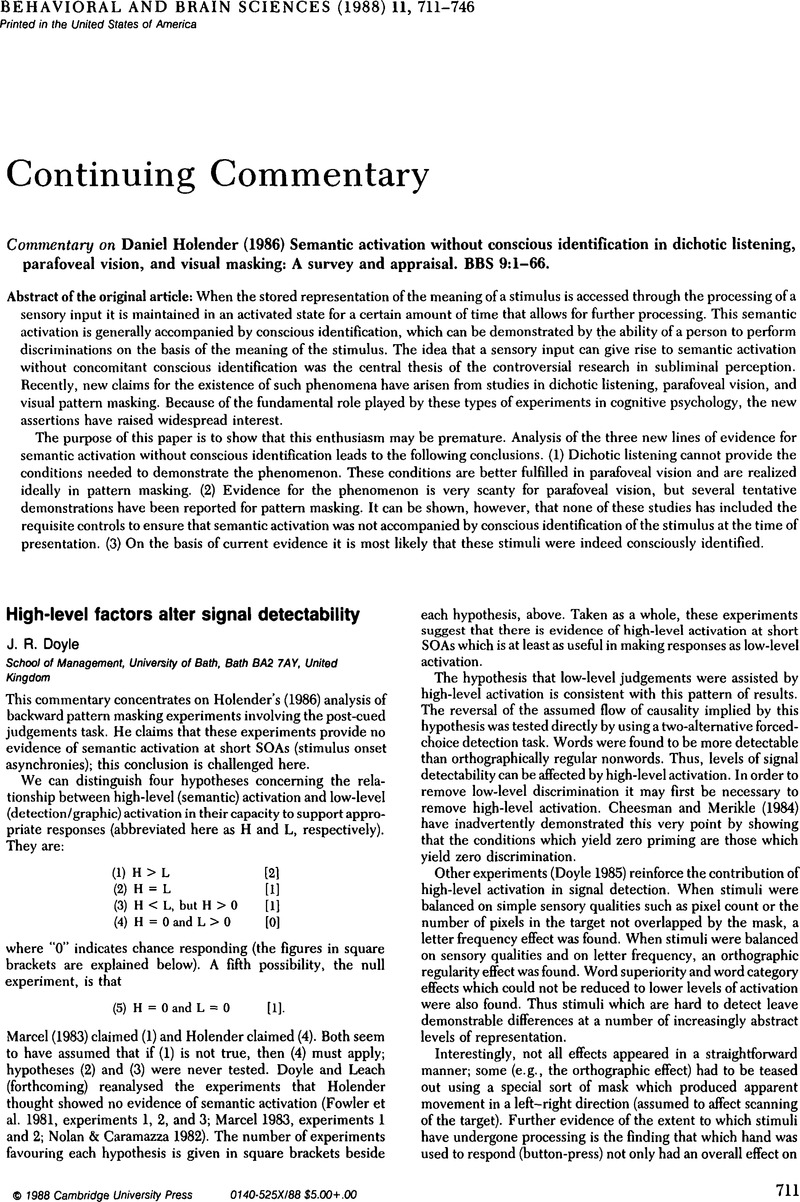No CrossRef data available.
Article contents
Toward a new paradigm of hypnosis: A model combining the social-psychological and special-processes paradigms
Published online by Cambridge University Press: 04 February 2010
Abstract
An abstract is not available for this content so a preview has been provided. Please use the Get access link above for information on how to access this content.

- Type
- Continuing Commentary
- Information
- Copyright
- Copyright © Cambridge University Press 1988
References
Barber, T. X. & Calverley, D. S. (1965) Empirical evidence for a theory of hypnotic behavior: Effects on suggestibility of five variables typically included in hypnotic induction procedures. Journal of Consulting Psychology 29:98–107.CrossRefGoogle ScholarPubMed
Coe, W. C. (1983) Trance: A problematic metaphor for hypnosis. Paper presented at the annual meeting of the American Psychological Association, Anaheim, Calif., 08 29.Google Scholar
Conn, J. H. & Conn, R. N. (1967) Discussion of T. X. Barber's “Hypnosis as a causal variable in present-day psychology: A critical analysis.” International Journal of Clinical and Experimental Hypnosis 24:287–99.Google Scholar
Freud, S. (1921/1981) Psychologie des foules et analyse du moi. In: Essais de Psychanalyse. Paris: Payot.Google Scholar
Gorassini, D. R. (1987a) Phenomenal awareness and self-presentation. Behavioral and Brain Sciences 10:519–20.CrossRefGoogle Scholar
Gorassini, D. R. (1987b) Use of concurrent verbalization to assess the dissociation of cognitive controls. Journal of Abnormal Psychology 96:218–20.CrossRefGoogle Scholar
Hilgard, E. R. (1977b) The problem of divided consciousness: A neodissociation interpretation. Annals of the New York Academy of Sciences 296:48–59.CrossRefGoogle ScholarPubMed
Hilgard, E. R. & Tart, C. T. (1966) Responsiveness to suggestions following waking and imagination instructions and following induction of hypnosis. Journal of Abnormal Psychology 71:196–208.CrossRefGoogle ScholarPubMed
Janet, P. (1889/1973) L'automatisme psychologique: Essai de psychologie expérimentale surles formes inférieures de l'activé humaine. Société Pierre Janet, Laboratoire de Psychologie Pathologique de la Sorbonne with the cooperation of Centre National de la Recherche Scientifique, Paris.Google Scholar
Lynn, S. J., Rhue, J. W. & Weekes, J. R. (in press) Hypnosis and experienced nonvolition: An integrative social-cognitive model. In: Hypnosis: Cognitive-behavioral perspectives, ed. Spanos, N. P. & Chaves, J. F., Prometheus.Google Scholar
Michaux, D. (1982) Aspects expérimentaux et cliniques de l'hypnose. Ph.D. thesis, University of Paris, unpublished.Google Scholar
Nash, M. (1987) What, if anything, is regressed about hypnotic age regression? A review of the empirical literature. Psychological Bulletin 102:42–52.CrossRefGoogle Scholar
Orne, M. T. (1959a) The demand characteristics of an experimental design and their implications. Paper presented at the meeting of the American Psychological Association, Cincinnati, 09.Google Scholar
Orne, M. T. (1959b) The nature of hypnosis: Artifact and essence. Journal of Abnormal and Social Psychology 58:277–99.CrossRefGoogle ScholarPubMed
Radtke, H. L. & Spanos, N. P. (1981) Was I hypnotized? A social psychological analysis of hypnotic depth reports. Psychiatry 44:359–76.Google Scholar
Sarbin, T. R. (1950) Contributions to role-taking theory: 1. Hypnotic behavior. Psychological Review 57:172–80.Google Scholar
Sarbin, T. R. (1984) Nonvolition in hypnosis: A semiotic analysis. Psychological Record 34:537–49.Google Scholar
Sarbin, T. R. & Allen, V. L. (1968) Role theory. In: Handbook of social psychology, vol. 1, ed. Lindzey, G. & Aronson, E.. Addison-Wesley.Google Scholar
Sarbin, T. R. & Coe, W. C. (1972) Hypnosis: A social-psychological analysis of influence communication. Holt, Rinehart & Winston.Google Scholar
Spanos, N. P. (1986) Hypnosis, nonvolitional responding and multiple personality: A social psychological perspective. In: Progress in experimental personality research, vol. 14, ed. Maher, B. & Maher, W.. Academic Press.Google Scholar
Spanos, N. P. (1986a) Hypnotic behavior: A social-psychological interpretation of amnesia, analgesia, and “trance logic.” Behavioral and Brain Sciences 9:449–502.CrossRefGoogle Scholar
Spanos, N. P. & Gorassini, D. R. (1984) The structure of hypnotic test suggestions and attributions of responding involuntarily. Journal of Personality and Social Psychology 46:688–96.Google Scholar
Spanos, N. P., MacDonald, D. K. & Gwynn, M. I. (1988) Instructional set and the relative efficacy of hypnotic and waking analgesia. Canadian Journal of Behavioral Science 20:64–72.CrossRefGoogle Scholar
Spanos, N. P. & Radtke, H. L. (1981) Hypnotic visual hallucinations as imaginings: A cognitive social-psychological perspective. Imagination Cognition and Personality 1:147–70.Google Scholar
Wagstaff, G. F. (1986) State versus nonstate paradigms of hypnosis: A real or a false dichotomy? Behavioral and Brain Sciences 9:486–87.CrossRefGoogle Scholar
White, R. W. (1937/1965) Two types of hypnotic trance and their personality correlates. In: The nature of hypnosis: Selected basic readings, ed. Shor, R. E. & Orne, M. T.. Holt, Rinehart and Winston.Google Scholar


